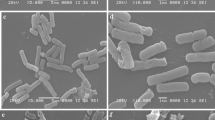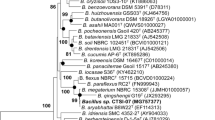Abstract
A chromium-reducing strain QH-1, identified as Bacillus sp., was isolated from soil under chromium-containing slag heap in Qinghai high altitude area, China. The strain was found to resist 200 mg/L Cr(VI), and Cr(VI) negatively affects the metabolic activity of the cells, as well as the cell morphology of Bacillus sp. QH-1. The reduction efficiency of Cr(VI) at concentrations of Cr(VI) 25 mg/L, 50 mg/L, 100 mg/L and 200 mg/L were 99.48 %, 65.99 %, 23.22 % and 6.99 %, respectively, decreasing with increasing initial Cr(VI) concentration. This indicates that the toxicity of Cr(VI) increased with concentration. Energy dispersive X-ray analysis revealed that there was insoluble Cr(III) generated during Cr(VI) reduction. In order to apply strain QH-1 to remove Cr(VI) from groundwater, factors of concentration of electron donors (glucose) and temperature were investigated in a synthetic medium. The results demonstrated that glucose could promote the reduction of Cr(VI) by this strain, and the general trend of Cr(VI) reduction increased with temperature within the range of 4 to 37 °C. Cr(VI) was reduced effectively at 25 °C and 37 °C, and all of Cr(VI) was reduced after 96 h at 37 °C, while the reduction was slow at 4 °C and 15 °C, and it almost ceased after about 120 h. These results could be potentially useful for the bioremediation of Cr(VI) in groundwater.






Similar content being viewed by others
References
Ackerley DF, Gonzalez CF, Park CH, Blake R, Keyhan A, Matin A (2004) Chromate-reducing properties of soluble Flavoproteins from Pseudomonas putida and Escherichia coli. Appl Environ Microb 70:873–882
Chaudhuri M, Bin Azizan NK (2012) Adsorptive removal of chromium(VI) from aqueous solution by an agricultural waste-based activated carbon. Water Air Soil Poll 223:1765–1771
Cheng GJ, Li XH (2009) Bioreduction of chromium(VI) by Bacillus sp. isolated from soils of iron mineral area. Eur J Soil Biol 45:483–487
Dogan NM, Kantar C, Gulcan S, Dodge CJ, Yimaz BC, Mazmanci MA (2011) Chromium(VI) bioremoval by Pseudomonas bacteria: role of microbial exudates for natural attenuation and biotratment of Cr(VI) contamination. Environ Sci Technol 45:2278–2285
Elangovan R, Abhipsa S, Rohit B, Ligy P, Chandraraj K (2006) Reduction of Cr(VI) by a Bacillus sp. Biotechnol Lett 28(4):247–252
Focardi S, Pepi M, Landi G, Gasperini S, Ruta M, Di Biasio P, Focardi SE (2012) Hexavalent chromium reduction by whole cell and cell free extract of the moderate halophilic bacterial strain Halomonas sp. TA-04. Int Biodeter Biodegr 66:63–70
Garbisu C, Alkorta I, Llama MJ, Serra JL (1998) Aerobic chromate reduction by Bacillus subtilis. Biodegradation 9:133–141
Garg SK, Tripathi M, Singh SK, Singh A (2013) Pentachlorophenol dechlorination and simultaneous Cr6+ reduction by Pseudomonas putida SKG-1 MTCC(10510): characterization of PCP dechlorination products, bacterial structure, and functional groups. Environ Sci Pollut Res 20(4):2288–2304
Kathiravan MN, Karthick R, Muthukumar K (2011) Ex situ bioremediation of Cr(VI) contaminated soil by Bacillus sp.: Batch and continuous studies. Chem Eng J 169:107–115
Kotas J, Stasicka Z (2000) Chromium occurrence in the environment and methods of its speciation. Environ Pollut 107:263–283
Lee SE, Lee JU, Chon HT, Lee JS (2008a) Microbiological reduction of hexavalent chromium by indigenous chromium-resistant bacteria in sand column experiments. Environ Geochem and Health 30:141–145
Lee SE, Lee JU, Chon HT, Lee JS (2008b) Reduction of Cr(VI) by indigenous bacteria in Cr-contaminated sediment under aerobic condition. J Geochem Explor 96:144–147
Liu YG, Xu WH, Zeng GM, Li X, Gao H (2006) Cr(VI) reduction by Bacillus sp. isolated from chromium landfill. Process Biochem 41:1981–1986
McLean J, Beveridge TJ (2001) Chromate reduction by a Pseudomonad isolated from a site contaminated with chromated copper arsenate. Appl Environ Microbiol 67:1076–1084
Megharaj M, Avudainayagam S, Naidu R (2004) Toxicity of hexavalent chromium and its reduction by bacteria isolated from soil contaminated with tannery waste. Curr Microbiol 47:51–54
Miretzky P, Cirelli AF (2010) Cr(VI) and Cr(III) removal from aqueous solution by raw and modified lignocellulosic materials: A review. J Hazard Mater 180:1–19
Morales-Barrera L, Guillén-Jiménez FD, Ortiz-Moreno A, Villegas-Garrido TL, Sandoval-Cabrera A, Hernández-Rodríguez CH, Cristiani-Urbina E (2010) Ioslation, identification and characterization of a Hypocrea tawa strain with high Cr(VI) reduction potential. Biochem Eng J 40:284–292
Murugavelh S, Mohanty K (2012) Bioreduction of hexavalent chromium by free cells and cell free extracts of Halomonas sp. Chem Eng J 203:415–422
Neal AL, Lowe K, Daulton TL, Jones-Meehan J, Little BJ (2002) Oxidation state of chromium associated with cell surfaces of Shewanella oneidensis during chromate reduction. Appl Surf Sci 202:150–159
Nguema PF, Luo ZJ (2012) Aerobic chromium(VI) reduction by chromium-resistant bacteria isolated from activated sludge. Ann Microbiol 62:41–47
Philip L, Lyengar L, Venkobachar C (1998) Cr(VI) reduction by bacillus coagulans isolated from contaminated soils. J Environ Eng-Asce 124(12):1165–1170
Rai D, Sass BM, Moore DA (1987) Chromium(III) hydrolysis constants and solubility of chromium(III) hydroxide. Inorg Chem 26:345–349
Rehr AP, Small MJ, Matthews HS, Hendrickson CT (2010) Economic sources and spatial distribution of airborne chromium risks in the U.S. Environ Sci and Technol 44:2131–2137
Sarangi A, Krishnan C (2008) Comparison of in vitro Cr(VI) reduction by CFEs of chromate resistant bacteria isolated from chromate contaminated soil. Bioresource Technol 99:4130–4137
Sayel H, Bahafid W, Joutey NT, Derraz K, Benbrahim KF, Koraichi SI, EI Ghachtouli N (2012) Cr(VI) reduction by Enterococcus gallinarum isolated from tannery waste-contaminated soil. Ann Microbiol 62:1269–1277
Shetty KV, Namitha L, Rao SN, Narayani M (2012) Experimental investigation and artificial neural network-based modeling of batch reduction of hexavalent chromium by immobilized cells of newly isolated strain of chromium-resistant bacteria. Water Air Soil Poll 223:1877–1893
Shi Y, Chai LY, Yang ZH, Jing QX, Chen RH, Chen YH (2012) Identification and hexavalent chromium reduction characteristics of Pannonibacter phragmitetus. Bioproc Biosyst Eng 35:843–850
Sikora ER, Johnsom TM, Bullen TD (2008) Microbial mass-dependent fractionation of chromium isotopes. Geochim Cosmochim Ac 72:3631–3641
Unceta N, Seby F, Malherbe J, Donard OFX (2010) Chromium speciation in solid matrices and regulation: a review. Anal Bioanal Chem 397:1097–1111
Webster G, Newberry CJ, Fry JC, Weightman AJ (2003) Assessment of bacterial community structure in the deep sub-seafloor biosphere by 16S rDNA-based techniques: a cautionary tale. J Microbiol Methods 55(1):155–164
Zhu WJ, Chai LY, Ma ZM, Wang YY, Mao HJ, Zhao K (2006) Anaerobic reduction of hexavalent chromium by bacterial cells of Achromobacter sp. strain Ch1. Microbiolo Res 163(6):616–623
Zhu WJ, Yang ZH, Ma ZM, Chai LY (2008) Reduction of high concentrations of chromate by Leucobacter sp. CRB1 isolated from Changsha, China. World J Microb Biot 24:991–996
Zink S, Schoenberg R, Staubwasser M (2010) Isotopic fractionation and reaction kinetics between Cr(III) and Cr(VI) in aqueous media. Geochim Cosmochim Ac 74:5729–5745
Acknowledgments
This project was supported jointly by the National Natural Science Foundation of China (No. 40872157, No. 40830748), the National Program on Key Basic Research Project of China (973 Program) (No. 2010CB428802), the Research Fund for the Doctoral Program of Higher Education (No.20110145110003), the National High Technology Research and Development Program of China (863 Program) (2012AA062602), the Program for New Century Excellent Talents in University of Ministry of Education of China (No. NCET-07-0773), the Fundamental Research Funds for the Central Universities (No. CUGL100501) and the Critical Patented Projects in the Control and Management of the National Polluted Water Bodies (2012ZX07204-003-04).
Author information
Authors and Affiliations
Corresponding author
Rights and permissions
About this article
Cite this article
Xu, F., Ma, T., Shi, L. et al. Bioreduction of Cr(VI) by Bacillus sp. QH-1 isolated from soil under chromium-containing slag heap in high altitude area. Ann Microbiol 64, 1073–1080 (2014). https://doi.org/10.1007/s13213-013-0746-2
Received:
Accepted:
Published:
Issue Date:
DOI: https://doi.org/10.1007/s13213-013-0746-2




